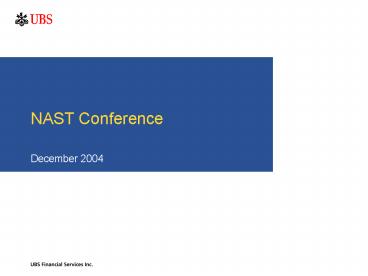NAST Conference - PowerPoint PPT Presentation
1 / 15
Title: NAST Conference
1
- NAST Conference
December 2004
2
Using Swaptions to Monetize Embedded Bond Options
- Most municipal bonds have a 10-year call
provision - The conventional way to monetize the value of an
issuers embedded bond call options is through a
refunding, but refundings only capture a portion
of the options value - The theoretically most efficient way to monetize
call value would be to detach the call from the
bond and sell the detached option - Swaptions provide issuers with a means of
synthetically capturing the full value of the
embedded bond option
3
Swaption Basics
- A swaption is the current sale of a future right
by Issuer to a swap counterparty to enter into an
interest rate swap on the call date - If the swap has value to counterparty,
counterparty would exercise its right to enter
into a swap - If the swap has no value to counterparty,
counterparty would allow the swap to expire
unexercised - The swaption premium paid by the Counterparty to
the Issuer represents the intrinsic value of the
swap (if exercised today) plus time value - There are three types of swaptions
- European are exercisable only at the strike date
- Bermudan (or Multi-European) are exercisable on a
certain date and at intervals thereafter (e.g.,
semiannually) up to another specified date - American are exercisable at any time up to and
including the strike date - If the counterparty does not exercise, Issuer
retains up-front premium and call option on
underlying bonds
4
Mechanics of a Swaption
At Sale of Swaption
At Exercise Date
A. Option is exercised and swap is executed
Issuer pays fixed rate and receives floating
rate. Issuer could issue floating rate bonds to
refund bonds and match swap obligation. Net debt
service post-refunding is essentially unchanged.
B. Option is not exercised under European
option, option terminates, Issuer keeps up-front
premium and retains call rights to the bonds
under Bermudan option, dealer holds additional
opportunities to exercise
5
The Value of the Option is Composed of Time Value
and Intrinsic Value
Components of Option Value
Option value ()
Market forward rate
Option premium ()
Intrinsic value
Time value
Point of maximum time value
Strike yield ()
Higher rates
Lower rates
6
Four Key Factors Primarily Determine the Value of
an Option
7
Option Pricing Sensitivity
8
Swaption Candidates Screen Example
9
Swaption Considerations
- Advantages
- Captures time value
- Can be repurchased at lower cost in higher rate
environment - Enhanced savings compared to forward starting
swaps - May provide greater value than an advance
refunding in a negative arbitrage environment - Applicable to non-advance refundable bonds
- Disadvantages
- No ability for Issuer to receive unwind payment
pre-exercise - May necessitate future floating rate bond issue
10
Swaps with Embedded Options
11
Credit Exposure Associated with Swaps
- Swaps pose two-way credit risk due to the two-way
nature of the payments - Similar to a fixed income security, a swap has a
market value that changes with movements in
interest rates - Because of their two-way nature, swaps can have a
positive or a negative value to the Issuer
depending on the features of the transaction and
the levels of interest rates - Two key features of swaps that serve to dampen
credit risk are - No principal component (notional amount not
exchanged) - Netting of fixed and floating payments
12
How Dealers Evaluate Credit Exposure
- Dealers assess credit exposure of the life of a
swap - Credit exposure models employ statistical
techniques to evaluate potential mark-to-market
values over the life of the transaction and over
varying potential interest rate environments - The dealers credit reserve for a transaction
reflects a combination of the mark-to-market
profiles and the issuers credit strength
13
How Issuers Evaluate Credit Exposure
- Issuers do not have access to credit departments
and sophisticated exposure models - Many issuers take a simplistic approach that uses
notional amount as a proxy for credit exposure - Unfortunately, notional amount is not an accurate
measure of credit exposure - Other important factors include duration and the
fixed swap rate - Some issuers have developed more refined
approaches for evaluating exposure
14
How Issuers Evaluate Credit Exposure
- Example of a More Sophisticated Issuer Approach
Towards Exposure
15
Managing Credit Risk
- Credit risk risk of a default by your
counterparty. Common mitigants include - Dealing with highly rated counterparties (Aa/AA
category or higher) - Collateral provisions
- Termination upon downgrade

